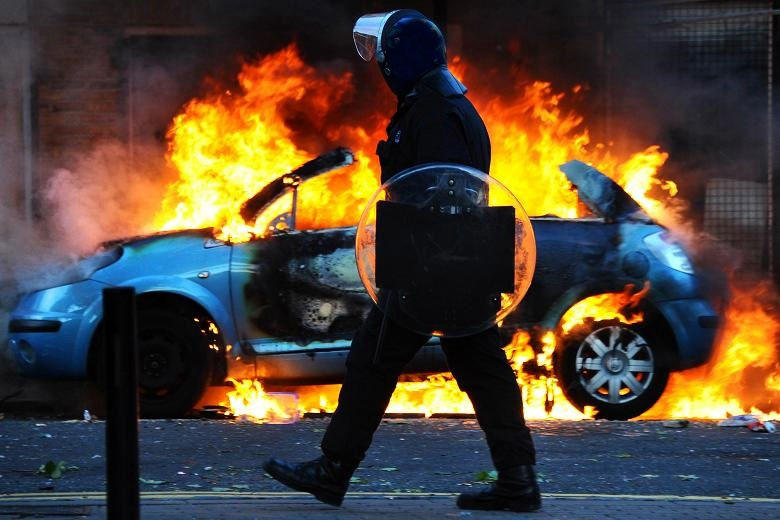by J. R. de Szigethy
Download the PDF for better viewing and printing here
Beginning on August 13, 2016, Milwaukee, Wisconsin was the settings for 3 days of rioting, arson, looting, and assaults against Police Officers following the shooting of an African-American man, Sylville Smith. The incident began when an African-American Police Officer pulled Smith and another man over in a traffic stop. Both men then bolted from their car and ran off, with Smith carrying a handgun. The cop knew Smith and was aware of his numerous arrests, including possession of heroin and cocaine charges, but most notably a shooting incident Smith was arrested for in 2015. A bodycam the Officer was wearing is reported to show Smith turning towards the Police Officer holding the gun, aimed in his direction, after which the Officer fired two shots at Smith.
In response to the shooting, dozens of citizens rioted. Several Police squad cars were destroyed, and Firefighters were assaulted with bricks and faced sniper fire from unseen assailants in the dark of night as they attempted to put out a fire at a gas station, which was among several small businesses set ablaze by the rioters. Four Police Officers were wounded during the riots, and to date over 20 people have been arrested.
Milwaukee Police Chief Edward Flynn, who is Caucasian, blamed the riots on members of the Chicago-based Revolutionary Communist Party, who used Social Media to direct members to protest Demonstrations. Milwaukee County Sheriff David Clarke, who is African-American, was far more critical, telling the Los Angeles Times that the rioters were members of a “culturally dysfunctional underclass.” Clarke also stated that “Black on Black violence” is much more lethal to African-Americans than confrontations with Police Officers. “Black LIES Matter!” said Sheriff Clarke, a denunciation of the “Black Lives Matter” movement.
Fortunately, because the two Police Officers involved in this incident were wearing body cams, determining exactly what happened can be ascertained in a relatively short period of time.
This was not the case in an incident that occurred on April 23, 1998. On that date New Jersey State Troopers John Hogan and James Kenna stopped a van for speeding on the New Jersey Turnpike. As the two were approaching the van from it’s rear, the van suddenly started rolling backwards, knocking Hogan to the ground. The two Troopers, fearing for their own lives as well as for the public safety, fired several shots from their service revolvers into the van, wounding 3 of it’s 4 occupants. The van then moved backwards a second time, crossing 2 lanes of traffic, where it struck another vehicle which burst into flames. The van then crashed down an embankment.
At that point, some Caucasian politicians denounced the Troopers as examples of racial profiling, demanding both a State prosecution and a Federal Civil Rights prosecution of the two. The National Police Defense Foundation then threw it’s resources behind the beleaguered Troopers. In September, 1999, a year and a half after the incident, both Troopers were Indicted by a State Grand Jury on attempted murder and assault charges. Both men faced up to 30 years in prison if convicted.
Courageously, the father of the van driver, Rodney Moore, called the Troopers “Scapegoats!” The Reverend Betty Neal, the Executive Director of the non-profit “Ministers of Harlem” organization, also weighed in on the controversy. Said the Reverend: “The Politicians are using (Hogan) as a sacrificial lamb!”
It wasn’t until August of 2000, over 2 years after the incident, that State investigators revealed to the Troopers’ Defense Team that for 5 months they had been sitting on explosive new evidence; two witnesses to the incident had been located, and their accounts corroborated what the Trooper’s had told investigators.
In January, 2002, almost 4 years after this case began, the State’s case against Troopers Hogan and Kenna was settled with their acceptance of a fine of $280.00 each. There would be no Federal Civil Rights charges by the government. Indeed, the Federal government, through the Drug Enforcement Administration, had trained New Jersey State Troopers to profile suspected drug traffickers through it’s “Operation: Pipeline,” which targeted a drug gang operating along the Eastern coast of America.
The drugs in question were cocaine, and they were being distributed primarily in the minority communities of New Jersey and New York. It was these communities that Troopers Hogan and Kenna were trying to protect from the scourge of drugs, but instead they were falsely accused of being prejudiced against these very communities. Some of those who falsely accused these men were Caucasian. Some who championed them were African-American.
So; how are the cases of Troopers Hogan and Kenna related to what is going on in Milwaukee?
Since the Police Foundation was founded over 20 years ago, the Foundation has advocated that all law enforcement agencies install dash cams and body cams as a required standard. Had the vehicle that Hogan and Kenna used to pull over the van in question been equipped with a dash cam, that camera would have recorded exactly what happened after the two State Troopers approached the van. Armed with that video evidence, it would not have taken almost 4 years, and the expenditure of an enormous amount of State and Federal resources, to resolve a case that resulted in the two men forfeiting a combined amount of $560.00. Dash cams and body cams are cost-efficient and protect cops from false accusations, thus the Police Foundation continues to advocate for their universal installation in America’s law enforcement agencies. Because the cops in Milwaukee were thus armed with these tools, that case could be resolved in as little as 4 months, not 4 years.
In 2005, John Hogan published his personal account of his ordeal in the book “Turnpike Trooper: Racial Profiling & the New Jersey State Police.”
*
J. R. de Szigethy is a New York City based crime reporter who can be reached at the following address: writer10065@nyc.rr.com

